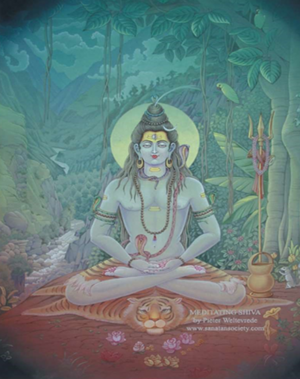Talk:The Eternal Body of Shiva in the Shaiva Āgamas
By Sri Vishal Agarwal
Similar to the Pāñcarātra school of Vaiṣṇavas, the followers of the Śaiva Āgama-s — now found mainly in Tamil Nadu, adjoining regions of South India, and in some areas of Sri Lanka and Malaysia — hold that Śiva is the Supreme Brahman, encompassing the attributes of the Trimūrti, and possessing an eternal body unaffected by the creation and dissolution of the universe.[1]
The Supreme has the Īśāna as His head, the Tatpuruṣa as His mouth, the Aghora as His heart, the Vāmadeva as His genitals, and the Sadyojāta as His feet. Sarvadarśanasaṅgraha, Chapter VIII
According to this doctrine, the divine body of Śiva is not composed of the three guṇa-s of prakṛti, nor is it subject to karm or material nature. Instead, it is said to consist of pure śakti (energy), identified with the five mantras referenced in Śaiva scriptures.
This body, produced by Śiva’s own will, is considered the basis for His five functions: grace, obscuration, dissolution, preservation, and creation. It is described as invisible and imperceptible.
The Śaiva tradition does not deny the other forms of Śiva but interprets them as manifestations assumed out of compassion. The rationale is that it is difficult for devotees to meditate upon or worship a deity without form, and therefore, Śiva makes Himself accessible through diverse representations.
References[edit]
- ↑ Cowell, E. B. Sarva Darsana Samgraha: Review of the Different Systems of Hindu Philosophy. 1900.

